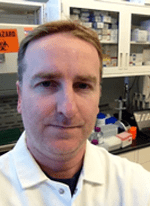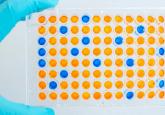Commentary on the Automation survey results

J oseph Tweed is a bioanalytical scientist working at Pfizer Inc. located in Groton, CT, USA. Joseph has over 18 years of multi-disciplinary experience in the areas of drug discovery, drug development and pharmacology research. He is responsible for developing and directing automated bioanalytical techniques that can improve the quality and the efficiency of day-to-day laboratory operations. He is actively engaged in pursuing automated innovations for use in the regulated bioanalysis of small-molecules, antibody-drug conjugates (ADCs) and biomarkers. Joseph received his B.S. from Drexel University, a M.S. from Thomas Jefferson University and his M.B.A from the University of New Haven.
oseph Tweed is a bioanalytical scientist working at Pfizer Inc. located in Groton, CT, USA. Joseph has over 18 years of multi-disciplinary experience in the areas of drug discovery, drug development and pharmacology research. He is responsible for developing and directing automated bioanalytical techniques that can improve the quality and the efficiency of day-to-day laboratory operations. He is actively engaged in pursuing automated innovations for use in the regulated bioanalysis of small-molecules, antibody-drug conjugates (ADCs) and biomarkers. Joseph received his B.S. from Drexel University, a M.S. from Thomas Jefferson University and his M.B.A from the University of New Haven.
Some interesting information can be gleaned from the recent automation survey published in the Bioanalysis Zone Spotlight. Overall, respondents feel automation provides fundamental benefits to the bioanalytical laboratory; however, the cost of automation platforms and a lack of collaborative efforts within the bioanalytical community pose significant challenges to the larger scale implementation of automation within the discipline. The survey details that a large majority of respondents (67%) employ automation in the laboratory. When combined with those who plan to implement automation in the laboratory (24%), we approach a consensus (91%) that indicates the utility automation affords the bioanalytical discipline. Not surprisingly, the survey details that the majority (52%) of automation use within the bioanalytical discipline is focused on small molecule analysis. However, the survey also details that only 20% of respondents use automation for large molecule analysis and a slightly higher percentage (28%) use the automation for both large and small molecule bioanalysis. For those large molecule respondents who do not use automation routinely, the data leaves us asking why this number is low. A possible explanation could be that small molecule bioanalysis has been routinely automated for decades, and as a result, has had a longer time to mature and refine with the hardware, software, processes and procedures critical to consistent and reproducible assay results. Additionally, automation of large molecule bioanalytical workflows typically requires tighter integration with peripherals such as incubators, plate washers etc., and astute programming competency which can take considerable time and resources to deliver a reliable and robust automated solution. Regardless of the disparity, this gap will close with time as automated hardware and software continue to mature within their respective bioanalytical disciplines.
Not surprisingly, the costs associated with automation reveal a major limitation in the broader implementation of automation across the bioanalytical discipline. Allocating funds for automated hardware and software in our present-day, resource-constrained bioanalytical laboratory continues to be a challenge. As the scope and complexity of any bioanalytical workflow increases, the cost of implementing that strategy increases as well. As a result, we often require dedicated hardware, software, resources (full-time equivalents), and overhead (compliance and maintenance) to fulfill the successful implementation of a desired automated bioanalytical workflow, all of which typically require a significant investment. Unfortunately, it is unlikely that the overall costs associated with automation implementation in the bioanalytical laboratory will significantly decrease over time. Turn-key automated solutions are rare within the small and large molecule bioanalytical disciplines, and even when simple and ‘low-cost’ automated workflows are implemented, the resulting investment in hardware and/or resources can easily approach US$30–50K.
While there may be preconceived notions of robots and automation replacing jobs in other industries, a majority of respondents (69%) feel that automated workflows do not jeopardize job security. This speaks to the reality of the bioanalytical workflows that are managed and executed within academia and industry. Although respondents recognize the value, capability, efficiency and quality that automation routinely provides they also recognize that building quality automated platforms often requires scientists with competencies and skills that evolve with our science and are refined with advancing technology. Thus, there will continue to be opportunities for bioanalytical scientists to find new approaches to apply technology in new and interesting ways to advance our drug discovery and development portfolios with increased quality and efficiency.
Lastly, an overwhelming majority of respondents (89%) detail that increased collaboration among the instrument vendors and scientists is absolutely needed. This is a clear indication that nearly all respondents from any bioanalytical laboratory want more out of the relationship between the vendor and the bioanalyst. Furthermore, this data indicates that within the community of bioanalytical scientists engaged in automation, we are not doing enough to collaborate. As industry and academic automation scientists, many of us participate in groups such as Standards in Laboratory Automation (SiLA, sila-standard.org) and regional Laboratory Robotics Interest Groups (LRIG) and attend annual conferences held by the Society for Laboratory Automation and Screening (SLAS) and the European laboratory Automation (ELA). Despite this, we feel there is still a lack of collaboration, which leaves us thinking about what else can be done. As with any collaboration, openness and the sharing of knowledge are critical to success. For the majority of academic laboratories, this presents no major challenges or concerns. However, this leaves us with a question, is there a future in which competing vendors and pharmaceutical laboratories actively collaborate to advance automation within the bioanalytical discipline? Only time will tell.
To view the survey infographic click here.
Click here to view the automation Spotlight panel discussion, which Joseph took part in.





